seat memory SKODA OCTAVIA 2014 3.G / (5E) Owner's Manual
[x] Cancel search | Manufacturer: SKODA, Model Year: 2014, Model line: OCTAVIA, Model: SKODA OCTAVIA 2014 3.G / (5E)Pages: 280, PDF Size: 35.53 MB
Page 32 of 280
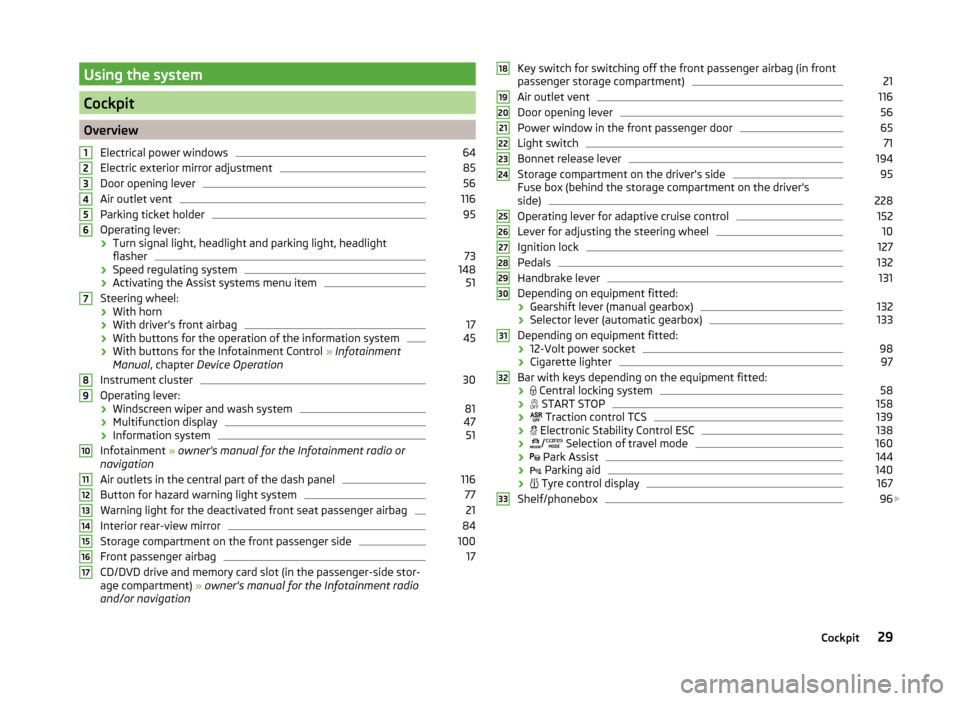
Using the system
Cockpit
OverviewElectrical power windows
64
Electric exterior mirror adjustment
85
Door opening lever
56
Air outlet vent
116
Parking ticket holder
95
Operating lever:
› Turn signal light, headlight and parking light, headlight
flasher
73
› Speed regulating system
148
›Activating the Assist systems menu item
51
Steering wheel:
› With horn
› With driver’s front airbag
17
›With buttons for the operation of the information system
45
›With buttons for the Infotainment Control
» Infotainment
Manual , chapter Device Operation
Instrument cluster
30
Operating lever: › Windscreen wiper and wash system
81
›Multifunction display
47
›Information system
51
Infotainment
» owner's manual for the Infotainment radio or
navigation
Air outlets in the central part of the dash panel
116
Button for hazard warning light system
77
Warning light for the deactivated front seat passenger airbag
21
Interior rear-view mirror
84
Storage compartment on the front passenger side
100
Front passenger airbag
17
CD/DVD drive and memory card slot (in the passenger-side stor-
age compartment) » owner's manual for the Infotainment radio
and/or navigation
1234567891011121314151617Key switch for switching off the front passenger airbag (in front
passenger storage compartment)21
Air outlet vent
116
Door opening lever
56
Power window in the front passenger door
65
Light switch
71
Bonnet release lever
194
Storage compartment on the driver's side
95
Fuse box (behind the storage compartment on the driver's
side)
228
Operating lever for adaptive cruise control
152
Lever for adjusting the steering wheel
10
Ignition lock
127
Pedals
132
Handbrake lever
131
Depending on equipment fitted:
› Gearshift lever (manual gearbox)
132
›Selector lever (automatic gearbox)
133
Depending on equipment fitted:
› 12-Volt power socket
98
›Cigarette lighter
97
Bar with keys depending on the equipment fitted:
›
Central locking system
58
›
START STOP
158
›
Traction control TCS
139
›
Electronic Stability Control ESC
138
›
/
Selection of travel mode
160
›
Park Assist
144
›
Parking aid
140
›
Tyre control display
167
Shelf/phonebox
96
1819202122232425262728293031323329Cockpit
Page 88 of 280
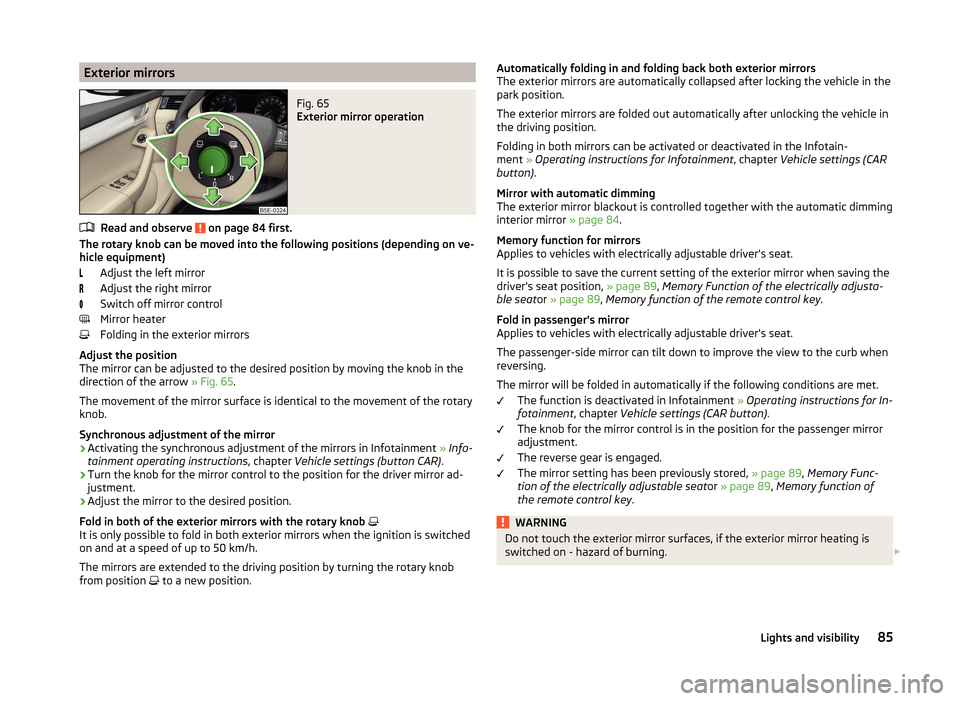
Exterior mirrorsFig. 65
Exterior mirror operation
Read and observe on page 84 first.
The rotary knob can be moved into the following positions (depending on ve-hicle equipment)
Adjust the left mirror
Adjust the right mirror
Switch off mirror control
Mirror heater
Folding in the exterior mirrors
Adjust the position
The mirror can be adjusted to the desired position by moving the knob in the
direction of the arrow » Fig. 65.
The movement of the mirror surface is identical to the movement of the rotary
knob.
Synchronous adjustment of the mirror
›
Activating the synchronous adjustment of the mirrors in Infotainment » Info-
tainment operating instructions , chapter Vehicle settings (button CAR) .
›
Turn the knob for the mirror control to the position for the driver mirror ad-
justment.
›
Adjust the mirror to the desired position.
Fold in both of the exterior mirrors with the rotary knob
It is only possible to fold in both exterior mirrors when the ignition is switched
on and at a speed of up to 50 km/h.
The mirrors are extended to the driving position by turning the rotary knob
from position to a new position.
Automatically folding in and folding back both exterior mirrors
The exterior mirrors are automatically collapsed after locking the vehicle in the
park position.
The exterior mirrors are folded out automatically after unlocking the vehicle in
the driving position.
Folding in both mirrors can be activated or deactivated in the Infotain-
ment » Operating instructions for Infotainment , chapter Vehicle settings (CAR
button) .
Mirror with automatic dimming
The exterior mirror blackout is controlled together with the automatic dimming
interior mirror » page 84.
Memory function for mirrors
Applies to vehicles with electrically adjustable driver's seat.
It is possible to save the current setting of the exterior mirror when saving the
driver's seat position, » page 89, Memory Function of the electrically adjusta-
ble seat or » page 89 , Memory function of the remote control key .
Fold in passenger's mirror
Applies to vehicles with electrically adjustable driver's seat.
The passenger-side mirror can tilt down to improve the view to the curb when
reversing.
The mirror will be folded in automatically if the following conditions are met. The function is deactivated in Infotainment » Operating instructions for In-
fotainment , chapter Vehicle settings (CAR button) .
The knob for the mirror control is in the position for the passenger mirror
adjustment.
The reverse gear is engaged.
The mirror setting has been previously stored, » page 89, Memory Func-
tion of the electrically adjustable seat or » page 89 , Memory function of
the remote control key .WARNINGDo not touch the exterior mirror surfaces, if the exterior mirror heating is
switched on - hazard of burning. 85Lights and visibility
Page 89 of 280
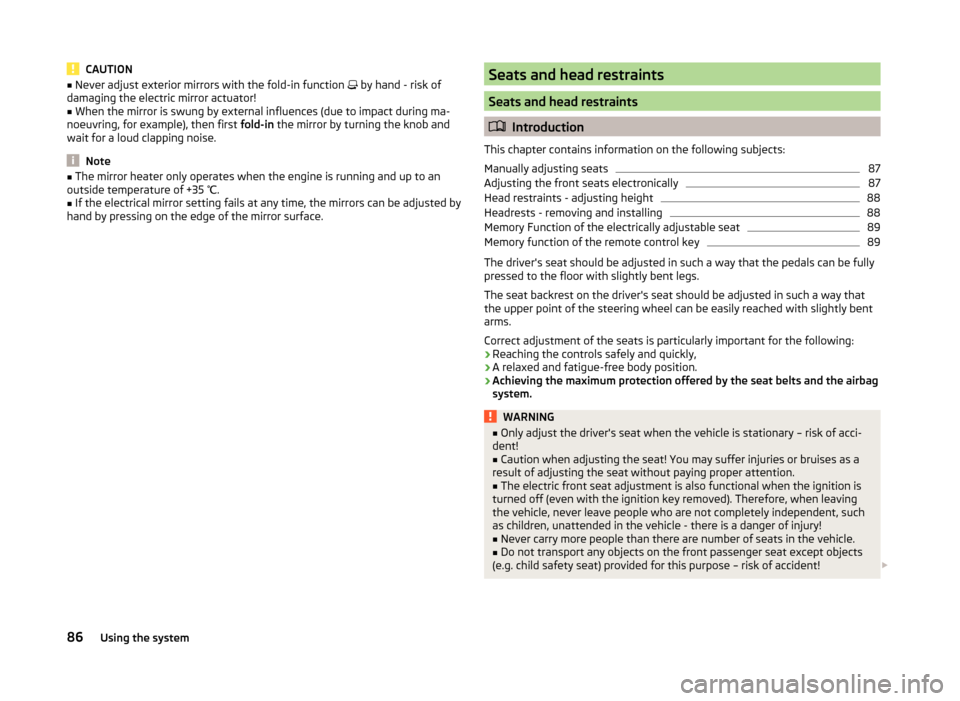
CAUTION■Never adjust exterior mirrors with the fold-in function by hand - risk of
damaging the electric mirror actuator!■
When the mirror is swung by external influences (due to impact during ma-
noeuvring, for example), then first fold-in the mirror by turning the knob and
wait for a loud clapping noise.
Note
■ The mirror heater only operates when the engine is running and up to an
outside temperature of +35 ℃.■
If the electrical mirror setting fails at any time, the mirrors can be adjusted by
hand by pressing on the edge of the mirror surface.
Seats and head restraints
Seats and head restraints
Introduction
This chapter contains information on the following subjects:
Manually adjusting seats
87
Adjusting the front seats electronically
87
Head restraints - adjusting height
88
Headrests - removing and installing
88
Memory Function of the electrically adjustable seat
89
Memory function of the remote control key
89
The driver's seat should be adjusted in such a way that the pedals can be fully
pressed to the floor with slightly bent legs.
The seat backrest on the driver's seat should be adjusted in such a way that the upper point of the steering wheel can be easily reached with slightly bent
arms.
Correct adjustment of the seats is particularly important for the following: › Reaching the controls safely and quickly,
› A relaxed and fatigue-free body position.
› Achieving the maximum protection offered by the seat belts and the airbag
system.
WARNING■ Only adjust the driver's seat when the vehicle is stationary – risk of acci-
dent!■
Caution when adjusting the seat! You may suffer injuries or bruises as a
result of adjusting the seat without paying proper attention.
■
The electric front seat adjustment is also functional when the ignition is
turned off (even with the ignition key removed). Therefore, when leaving
the vehicle, never leave people who are not completely independent, such
as children, unattended in the vehicle - there is a danger of injury!
■
Never carry more people than there are number of seats in the vehicle.
■
Do not transport any objects on the front passenger seat except objects
(e.g. child safety seat) provided for this purpose – risk of accident!
86Using the system
Page 90 of 280
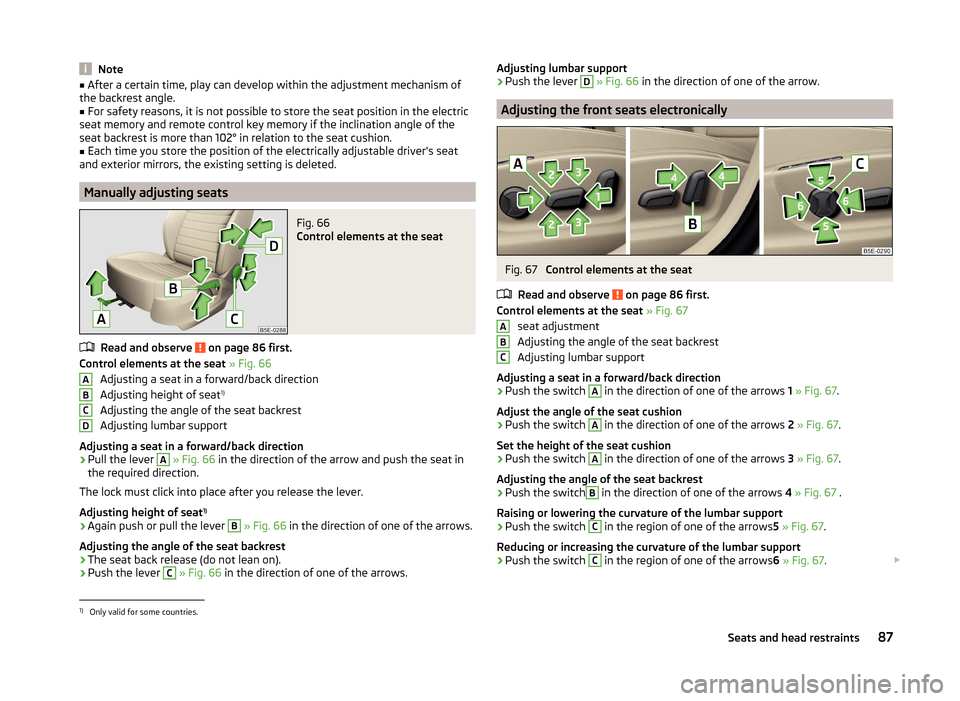
Note■After a certain time, play can develop within the adjustment mechanism of
the backrest angle.■
For safety reasons, it is not possible to store the seat position in the electric
seat memory and remote control key memory if the inclination angle of the
seat backrest is more than 102° in relation to the seat cushion.
■
Each time you store the position of the electrically adjustable driver's seat
and exterior mirrors, the existing setting is deleted.
Manually adjusting seats
Fig. 66
Control elements at the seat
Read and observe on page 86 first.
Control elements at the seat » Fig. 66
Adjusting a seat in a forward/back direction
Adjusting height of seat 1)
Adjusting the angle of the seat backrest
Adjusting lumbar support
Adjusting a seat in a forward/back direction
›
Pull the lever
A
» Fig. 66 in the direction of the arrow and push the seat in
the required direction.
The lock must click into place after you release the lever.
Adjusting height of seat 1)
›
Again push or pull the lever
B
» Fig. 66 in the direction of one of the arrows.
Adjusting the angle of the seat backrest
›
The seat back release (do not lean on).
›
Push the lever
C
» Fig. 66 in the direction of one of the arrows.
ABCDAdjusting lumbar support›Push the lever D » Fig. 66 in the direction of one of the arrow.
Adjusting the front seats electronically
Fig. 67
Control elements at the seat
Read and observe
on page 86 first.
Control elements at the seat » Fig. 67
seat adjustment
Adjusting the angle of the seat backrest
Adjusting lumbar support
Adjusting a seat in a forward/back direction
›
Push the switch
A
in the direction of one of the arrows 1 » Fig. 67 .
Adjust the angle of the seat cushion
›
Push the switch
A
in the direction of one of the arrows 2 » Fig. 67 .
Set the height of the seat cushion
›
Push the switch
A
in the direction of one of the arrows 3 » Fig. 67 .
Adjusting the angle of the seat backrest
›
Push the switch
B
in the direction of one of the arrows 4 » Fig. 67 .
Raising or lowering the curvature of the lumbar support
›
Push the switch
C
in the region of one of the arrows 5 » Fig. 67 .
Reducing or increasing the curvature of the lumbar support
›
Push the switch
C
in the region of one of the arrows 6 » Fig. 67 .
ABC1)
Only valid for some countries.
87Seats and head restraints
Page 91 of 280

The adjusted driver's seat position can be set in the memory of the
seat » page 89 or the remote control key » page 89.
Note
If the setting procedure is interrupted, you will need to press the button again.
Head restraints - adjusting height
Fig. 68
Front headrests: move up and
down
Fig. 69
Rear headrests: move up and down
Read and observe
on page 86 first.
Best protection is achieved if the top edge of the head rest is at the same level as the upper part of your head.
Adjust front support
›
Press the locking button
A
» Fig. 68 and hold and move support in the de-
sired direction.
Adjust rear support
›
Grasp the restraint and move upwards in the direction of
1
» Fig. 69 .
›To move the restraint
down, press the securing button B in the direction of
arrow 2 and hold while at the same time pressing the restraint in the direc-
tion of arrow 3
.
WARNINGWith seats occupied, the respective head rests must be correctly set (must
not be in the bottom position) - risk of fatal injury!
Note
■ The middle rear head restraint is only adjustable in two positions.■For the sports seats, the head restraints are integrated into the front seat
backrests. This headrest can not be adjusted in height.
Headrests - removing and installing
Fig. 70
Rear headrests: removing/installing
Read and observe
on page 86 first.
Only the real head restraints may be removed or installed.
›
Pull the head restraint out of the seat backrest as far as the stop.
›
Press the locking button
A
in the direction of arrow
1
» Fig. 70 , while at
the same time using a flat screwdriver with a max. width of 5 mm to press
the securing button in opening
B
in the direction of arrow
2
.
›
Remove the restraint in the direction of arrow
3
.
›
To re-insert the head restraint, push it far enough down in the direction of
arrow
4
into the seat backrest until the locking button clicks into place.
WARNINGWith seats occupied, the respective head rests must be installed and adjus- ted correctly - risk of fatal injury! 88Using the system
Page 92 of 280
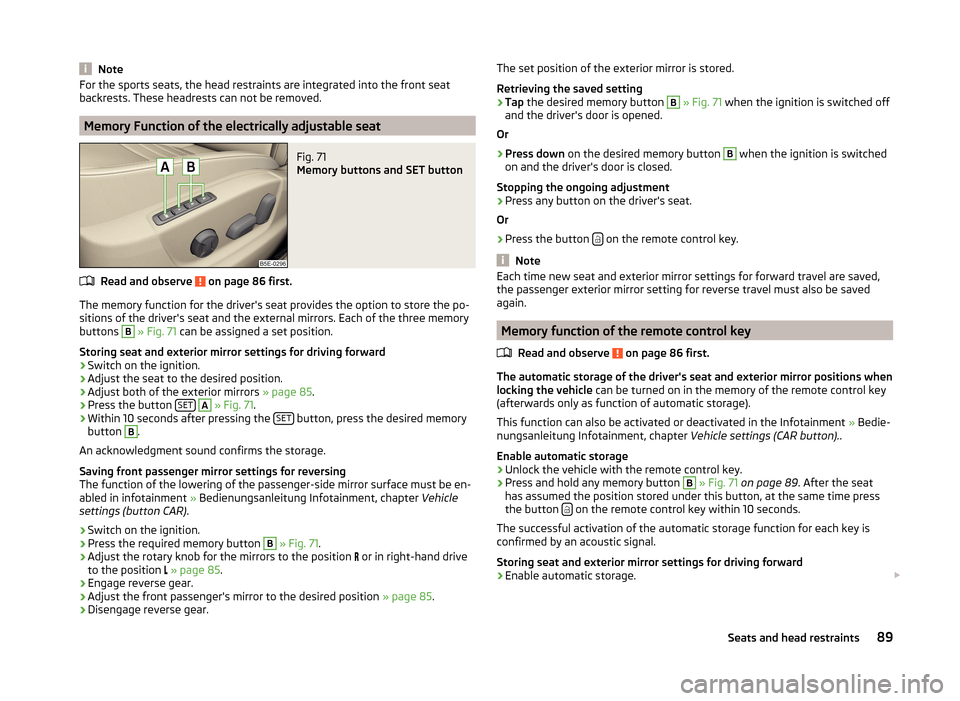
NoteFor the sports seats, the head restraints are integrated into the front seat
backrests. These headrests can not be removed.
Memory Function of the electrically adjustable seat
Fig. 71
Memory buttons and SET button
Read and observe on page 86 first.
The memory function for the driver's seat provides the option to store the po- sitions of the driver's seat and the external mirrors. Each of the three memory
buttons
B
» Fig. 71 can be assigned a set position.
Storing seat and exterior mirror settings for driving forward
›
Switch on the ignition.
›
Adjust the seat to the desired position.
›
Adjust both of the exterior mirrors » page 85.
›
Press the button SET
A
» Fig. 71 .
›
Within 10 seconds after pressing the SET button, press the desired memory
button
B
.
An acknowledgment sound confirms the storage.
Saving front passenger mirror settings for reversing
The function of the lowering of the passenger-side mirror surface must be en-
abled in infotainment » Bedienungsanleitung Infotainment, chapter Vehicle
settings (button CAR) .
›
Switch on the ignition.
›
Press the required memory button
B
» Fig. 71 .
›
Adjust the rotary knob for the mirrors to the position
or in right-hand drive
to the position
» page 85 .
›
Engage reverse gear.
›
Adjust the front passenger's mirror to the desired position » page 85.
›
Disengage reverse gear.
The set position of the exterior mirror is stored.
Retrieving the saved setting›
Tap the desired memory button
B
» Fig. 71 when the ignition is switched off
and the driver's door is opened.
Or
›
Press down on the desired memory button
B
when the ignition is switched
on and the driver's door is closed.
Stopping the ongoing adjustment
›
Press any button on the driver's seat.
Or
›
Press the button on the remote control key.
Note
Each time new seat and exterior mirror settings for forward travel are saved,
the passenger exterior mirror setting for reverse travel must also be saved
again.
Memory function of the remote control key
Read and observe
on page 86 first.
The automatic storage of the driver's seat and exterior mirror positions when
locking the vehicle can be turned on in the memory of the remote control key
(afterwards only as function of automatic storage).
This function can also be activated or deactivated in the Infotainment » Bedie-
nungsanleitung Infotainment, chapter Vehicle settings (CAR button)..
Enable automatic storage
›
Unlock the vehicle with the remote control key.
›
Press and hold any memory button
B
» Fig. 71 on page 89 . After the seat
has assumed the position stored under this button, at the same time press
the button
on the remote control key within 10 seconds.
The successful activation of the automatic storage function for each key is
confirmed by an acoustic signal.
Storing seat and exterior mirror settings for driving forward
›
Enable automatic storage.
89Seats and head restraints
Page 93 of 280
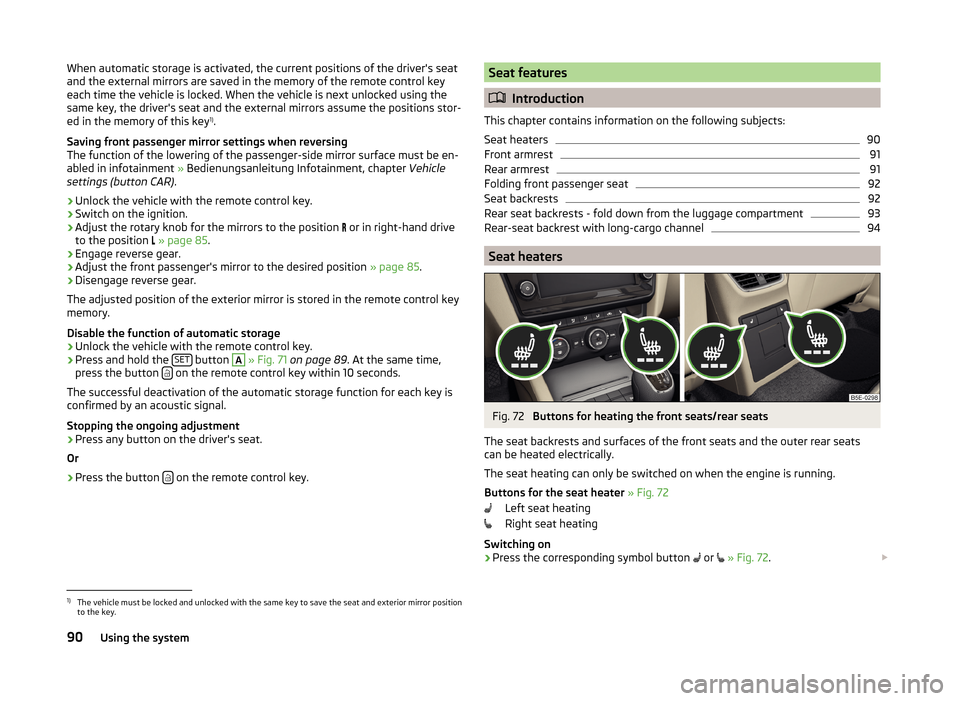
When automatic storage is activated, the current positions of the driver's seat
and the external mirrors are saved in the memory of the remote control key
each time the vehicle is locked. When the vehicle is next unlocked using the
same key, the driver's seat and the external mirrors assume the positions stor-
ed in the memory of this key 1)
.
Saving front passenger mirror settings when reversing
The function of the lowering of the passenger-side mirror surface must be en-
abled in infotainment » Bedienungsanleitung Infotainment, chapter Vehicle
settings (button CAR) .›
Unlock the vehicle with the remote control key.
›
Switch on the ignition.
›
Adjust the rotary knob for the mirrors to the position
or in right-hand drive
to the position
» page 85 .
›
Engage reverse gear.
›
Adjust the front passenger's mirror to the desired position » page 85.
›
Disengage reverse gear.
The adjusted position of the exterior mirror is stored in the remote control key
memory.
Disable the function of automatic storage
›
Unlock the vehicle with the remote control key.
›
Press and hold the SET button
A
» Fig. 71 on page 89 . At the same time,
press the button on the remote control key within 10 seconds.
The successful deactivation of the automatic storage function for each key is confirmed by an acoustic signal.
Stopping the ongoing adjustment
›
Press any button on the driver's seat.
Or
›
Press the button on the remote control key.
Seat features
Introduction
This chapter contains information on the following subjects:
Seat heaters
90
Front armrest
91
Rear armrest
91
Folding front passenger seat
92
Seat backrests
92
Rear seat backrests - fold down from the luggage compartment
93
Rear-seat backrest with long-cargo channel
94
Seat heaters
Fig. 72
Buttons for heating the front seats/rear seats
The seat backrests and surfaces of the front seats and the outer rear seats
can be heated electrically.
The seat heating can only be switched on when the engine is running.
Buttons for the seat heater » Fig. 72
Left seat heating
Right seat heating
Switching on
›
Press the corresponding symbol button or
» Fig. 72 .
1)
The vehicle must be locked and unlocked with the same key to save the seat and exterior mirror position
to the key.
90Using the system
Page 269 of 280

lock steering lock / unlockkey126
Long cargo channel94
Low beam71
Low tyre pressure warning See tyre pressure monitoring
167
Luggage compartment103
Compartment with cargo element108
Cover107
Emergency unlocking226
Fastening elements104
Fix floor covering106
Fixing nets105
floor covering on both sides106
foldable hook106
Folding double hooks105
Lighting103
Luggage net106
Net partition112
roll-up cargo cover108
Storage compartments under the floor cover- ing
109
Stowing the roof rack115
Unlocking the tailgate226
Variable loading floor110
Luggage compartment cover107
Luggage compartment lid60
Luggage net106
Luggage storage Multi-function pocket
110
M
Main beam
73
Warning light40
Maintenance see vehicle care
182
Manual air conditioning Air distribution control
117
Operating elements119
Manual gear changing see gear changing132
Manually adjusting seats
87
Manually adjusting seats87
MAXI DOT display50
Lap timer51
Main menu51
Operation46
Stop watch51
MAXI DOT see MAXI DOT display
50
Maximum permissible weights
238
Mechanical windows66
opening and closing67
Media see radio/navigation system
4
Memory48
Memory Function for the seat89
Mirror Exterior mirrors
85
Make-up81
Mirrors Interior mirror
84
MODE button see driving mode selection
160
Modifications177
Modifications and technical alterations Airbags
179
Service178
Spoiler179
Multi-collision brake140
Multi-function pocket110
Multifunction display Functions
47
Information48
Memory48
Operation46
Multimedia holder99
N
N1
110
Nameplate238
Natural gas operation Indicator light
40
Natural gas vehicles See CNG
192
Navigation system4
Net partition112
behind the front seats112
behind the rarer seats112
Removing and refitting the housing113
Nets105
Notes for driving with a repaired tyre220
Notes on using wheels204
O
Oil Information messages
42
See Engine oil196
Oil pressure Information messages
42
Onboard computer see multifunction display
47
Opening and closing sun roof - Version 1
67
sun roof - Version 269
Operate roller blind - Version 1
68
Operating weight239
Operation in winter Diesel fuel
190
Vehicle battery201
Optical Parking Assistant143
Function keys144
Operation143
Orientation lines144
266Index
Page 271 of 280
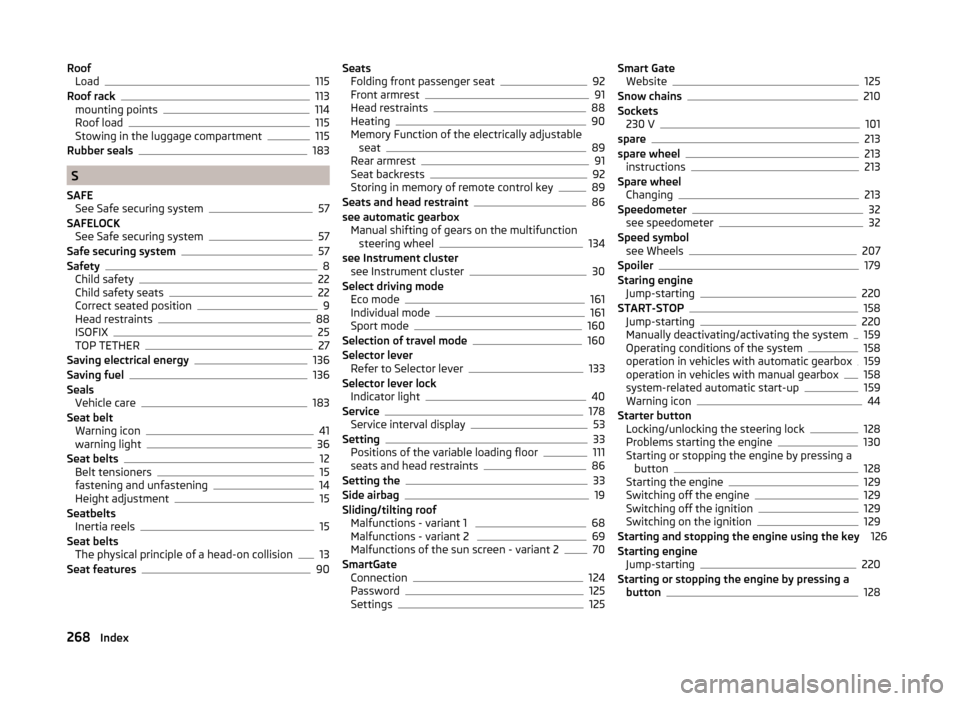
RoofLoad115
Roof rack113
mounting points114
Roof load115
Stowing in the luggage compartment115
Rubber seals183
S
SAFE See Safe securing system
57
SAFELOCK See Safe securing system
57
Safe securing system57
Safety8
Child safety22
Child safety seats22
Correct seated position9
Head restraints88
ISOFIX25
TOP TETHER27
Saving electrical energy136
Saving fuel136
Seals Vehicle care
183
Seat belt Warning icon
41
warning light36
Seat belts12
Belt tensioners15
fastening and unfastening14
Height adjustment15
Seatbelts Inertia reels
15
Seat belts The physical principle of a head-on collision
13
Seat features90
Seats Folding front passenger seat92
Front armrest91
Head restraints88
Heating90
Memory Function of the electrically adjustable seat
89
Rear armrest91
Seat backrests92
Storing in memory of remote control key89
Seats and head restraint86
see automatic gearbox Manual shifting of gears on the multifunction steering wheel
134
see Instrument cluster see Instrument cluster
30
Select driving mode Eco mode
161
Individual mode161
Sport mode160
Selection of travel mode160
Selector lever Refer to Selector lever
133
Selector lever lock Indicator light
40
Service178
Service interval display53
Setting33
Positions of the variable loading floor111
seats and head restraints86
Setting the33
Side airbag19
Sliding/tilting roof Malfunctions - variant 1
68
Malfunctions - variant 2 69
Malfunctions of the sun screen - variant 270
SmartGate Connection
124
Password125
Settings125
Smart Gate Website125
Snow chains210
Sockets 230 V
101
spare213
spare wheel213
instructions213
Spare wheel Changing
213
Speedometer32
see speedometer32
Speed symbol see Wheels
207
Spoiler179
Staring engine Jump-starting
220
START-STOP158
Jump-starting220
Manually deactivating/activating the system159
Operating conditions of the system158
operation in vehicles with automatic gearbox159
operation in vehicles with manual gearbox158
system-related automatic start-up159
Warning icon44
Starter button Locking/unlocking the steering lock
128
Problems starting the engine130
Starting or stopping the engine by pressing a button
128
Starting the engine129
Switching off the engine129
Switching off the ignition129
Switching on the ignition129
Starting and stopping the engine using the key 126
Starting engine Jump-starting
220
Starting or stopping the engine by pressing a button
128
268Index